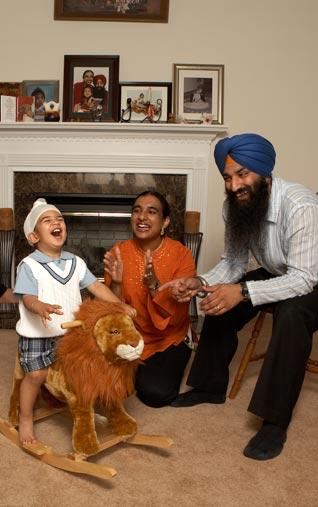Kids' Corner
A Happy Family:
Living Sikhi, Lesson # 31
by VERONICA SIDHU
Lesson Objectives
1 To learn about Guru Nanak's return to Punjab.
2 To appreciate how Guru Nanak taught by example, not just by words.
3 To understand a balanced daily routine and why it is important.
Teachers, ask the students to say the Sikh greeting with you; then fold hands and do simran with the students.
Homework Review
Remember the questions you were asked to answer for homework last week? Who would like to read what you wrote? If you remember that you may die at anytime, how would you change how you behaved yesterday? How would you change how you live today? (Pause for participation.)
Do you remember our very first lesson in Living Sikhi? What was it about? What did we do? (Pause for participation.) Yes, we learned from observing nature. We planted seeds and observed what they needed in order to grow into sturdy plants. They needed sunlight, but not too much; water, but not too much.
From our observations, we learned to understand the importance of moderation and balance. This is one of the lessons our great Teacher, Guru Nanak taught throughout his life in his baani (hymns) and by his example.
Let's read the last story in Book I of Stories From Sikh History by Singh and Dhillon, pp. 104-108.
We can see from reading these pages that Guru Nanak decided to return to Punjab after his four great journeys. When he settled in Kartarpur, he attracted many people around him. He lived with all types of people - those born into other religions, castes and degrees of wealth. He treated everyone like a member of his family. He could have retired - eating, sleeping and enjoying the company of his family and friends. Certainly, most people would tell him that he deserved to rest after so many grueling years of travel.
Yet, what did he do? (Pause.)
Right! He followed a disciplined program every day. He rose before the sun, bathed and meditated. He sang shabads with his followers and then gave a spiritual talk, teaching them more about God and about how to be truly happy. They ate a simple meal. He then worked in the fields doing what every farmer does. In the evening again he prayed and sang with them, then he enjoyed the company of all his "family" while they ate a meal together.
What can we say about this program? (Pause)
Yes, it was well balanced. Guru Nanak took care of his soul by quietly connecting with God every morning and doing simran throughout the day. He took care of his physical body by doing hard work in the fields and by eating simple meals. He took care of his emotional life by enjoying the company of others. And he shared his wisdom and his work - this was his seva. All the while his mind was on God. He and the others in the community were practicing the Three Golden Rules.
Do you remember the Three Golden Rules - in English and in Punjabi? (Pause.)
Right! Munn, Tunn, Dhunn, which stand for "MIND" (meditation, simran), "BODY" (honest work/ kirat karni) and "GIVING" (sharing with others/sev/ dusvundh).
Guru Nanak also put into practice the understandings he received when he visited Sach Khand, the Realm of Truth. In that high state, he was given the understanding that all men, women and children are brothers and sisters of the One God. Wherever he went on his travels, he practiced this in his daily life. Even though it was very unusual for those times, he stayed with people of all religions, all castes and all beliefs. So he continued to practice the same principles in Kartarpur. People ate the same meals together just like we do today in the langar hall.
Guru Nanak found that when people actually practiced the Three Golden Rules, they lived well and were happy and content. Everyone in his happy family practiced the rules every day.
Now we can continue to be part of this happy family, too. When we do simran, when we clean and care for our physical body, the place where we live and the environment; when we get good exercise and play well; when we study hard and do not cheat; when we share our time and things with others who are less fortunate; when we enjoy family and good, happy friends; when we keep on observing and learning every day that we are blessed in this life, in all these things we practice the balanced, good life that Guru Nanak so beautifully modeled for us. "Dhunn Guru Nanak!"
Homework
Make a schedule for yourself that balances simran, work and play every day. Enjoy a happy life!
Shabad
satgur aayo saran tuhaari
March 22, 2011
Conversation about this article
1: Dr. Jyotica (Erode, India), March 25, 2011, 1:02 PM.
Superbly depicted in a precise, understanding way for even 5 yrs., and, of course, above. But should be followed truly by everyone!




